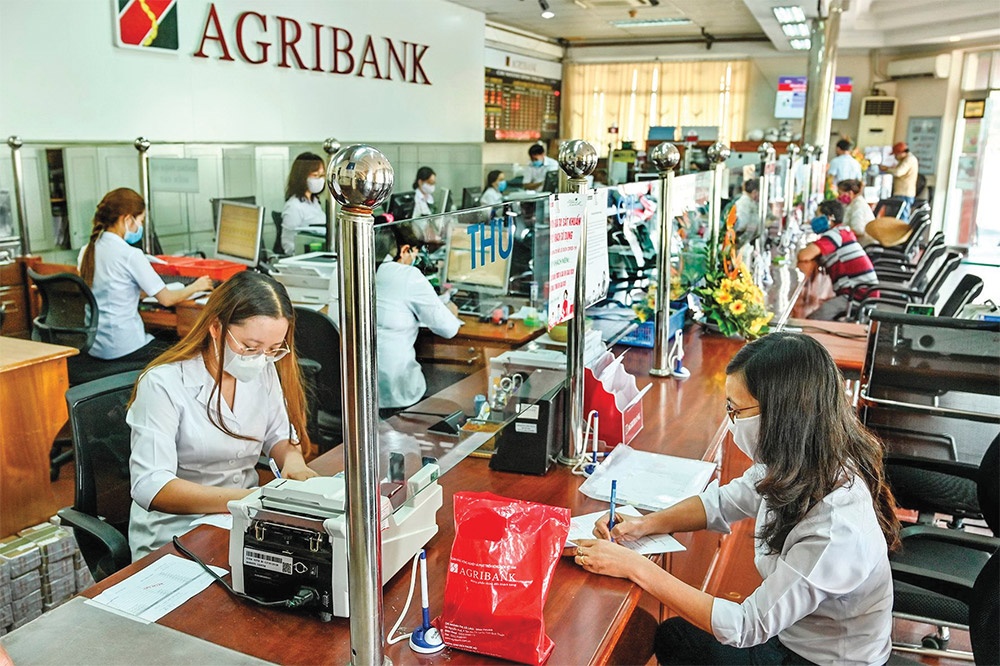Rising NPLs under increased pressure
The Q3 financial reporting season for all 27 listed banks as of October 31 has revealed a stark divergence in non-performing loan (NPL) levels across the sector with smaller banks seeing rising ratios, while larger banks, with substantial profit buffers, retain more capacity to manage these bad debts.
 |
| Agribank and others have proposed a debt regulation extension, photo Le Toan |
“At year-end NPLs may rise, shedding more light on the quality of banking sector assets. For banks with high ratios, their business performance is bound to suffer,” noted Bui Van Huy, Ho Chi Minh City branch director at DSC Securities.
Sacombank’s consolidated Q3 financial statement indicated on-balance-sheet NPLs reaching $541.63 million by the end of Q3, an increase of $83.96 million since the start of the year, with a 2.47 per cent ratio.
Similarly, PGBank saw a 16.6 per cent rise in NPLs by the end of September to $48.96 million, raising its ratio from 2.85 to 3.19 per cent. Nam A Bank reported a ratio of 2.85 per cent and aims to reduce it to 2 per cent, potentially adding $12.5-20.83 million in provisioning to lift its loan loss coverage ratio to 55-60 per cent.
Conversely, the largest state-owned commercial banks maintained relatively low NPL levels. BIDV’s NPLs rose to 1.71 per cent by the end of Q3, up from 1.26 per cent earlier this year.
VietinBank’s total NPLs increased by over $713.88 million, driving its ratio from 1.12 per cent at the beginning of the year to 1.44 per cent.
As of end of September, Vietcombank’s NPLs amounted to $714.58 million, representing 1.22 per cent of total loans, and it maintained the highest NPL coverage ratio in the industry at 212.1 per cent, down 18.2 percentage points from last year, yet 2.5 times the industry average.
During the State Bank of Vietnam’s (SBV) Q3 press conference in mid-October, Deputy Governor Dao Minh Tu said that NPLs are on the rise, and the growth rate is concerning. “Currently, the on-balance-sheet ratio is nearing 5 per cent. Including potential future NPLs, this rate could reach 6-9 per cent. Moreover, Typhoon Yagi’s recent impact has inflicted significant damage on key economic areas, particularly the agricultural and aquaculture sectors,” Tu said.
According to the SBV’s report, key drivers of rising NPLs stem from a mix of macroeconomic conditions and natural disasters.
Financial expert Nguyen Tri Hieu observed that many businesses’ financial health remains weak, contributing to NPL growth. “Banks now face additional pressures to lower lending rates and offer support packages for clients in typhoon-affected areas, which will further erode profits and elevate NPL risk. The banking sector depends on the survival and growth of businesses and individuals. As companies face hardships, credit recovery slows, and bad debt management appears far from a resolution,” Hieu said.
With 70 per cent of bank collateral tied to real estate, liquidity issues in this market make it difficult for banks to dispose of collateral through foreclosure, often at a loss due to depreciated asset values. “Banks that concentrate excessively on real estate credit, while neglecting other sectors, face NPL risk. Many real estate companies are leveraging at 4-5 times equity, creating a default risk if the market struggles,” added Hieu.
In this context, many banks have called on the SBV to implement supportive mechanisms, especially in extending loan restructuring periods for clients affected by natural disasters.
Executives at HDBank and Agribank have proposed that the government extend the effective date of Circular No.06/2024/TT-NHNN, allowing for debt restructuring and rescheduling until mid-2025.
In addition to potential NPL increases, this year’s debt recovery efforts have faced heightened challenges due to the expiration of Resolution No.42/2017/QH14, which previously enabled expedited NPL handling.
Techcombank’s chairman also urged measures to stabilise and revitalise capital flows in the corporate bond market, citing significant regulatory changes under the draft Securities Law that could adversely affect the capital market and hinder corporate fundraising.
“The Ministry of Finance must assess these impacts on markets, businesses, and citizens, and consider the feedback from enterprises and associations to make balanced adjustments, fostering both market stability and sustainable corporate funding,” stated Ho Hung Anh, chairman of Techcombank.
Dang Khac Vy, chairman of VIB, suggested that the government instruct relevant ministries to authorise credit institutions to exercise collateral seizure rights as a means to expedite debt recovery.
“This right should be granted when the collateral agreement includes three conditions: a provision allowing seizure as a collateral handling method, a clause granting seizure rights to the institution, and an outlined process for asset recovery,” Vy said.
 | Assessment of non-performing loans so far in 2024 The non-performing loan (NPL) ratio reached nearly 5 per cent at the end of May. Le Hoai An, a banking consultant and trainer at Integrated Financial Solutions, talked with VIR’s Hong Dung the assessment of NPLs in the first half of 2024. |
 | Addressing legal gaps for resolving non-performing loans Legal obstacles and inconsistencies prolonging the debt resolution process, lack of specific guidance on the entrusted handling of secured assets, and the low legal compliance of judgment debtors are the main factors affecting the recovery of non-performing loans and the clearance of credit flows by banks. |
What the stars mean:
★ Poor ★ ★ Promising ★★★ Good ★★★★ Very good ★★★★★ Exceptional
Related Contents
Latest News
More News
- Tax sector wraps up 2025 and sets priorities for next year (December 25, 2025 | 14:00)
- A tipping point for digital and hybrid wealth management in Vietnam (December 23, 2025 | 13:33)
- $250 million deal targets women-owned SMEs, sustainable agriculture (December 22, 2025 | 17:40)
- Stock market posts resilient 2025 performance (December 19, 2025 | 18:17)
- Citi Vietnam receives 2025 AmCham CSR recognition (December 19, 2025 | 16:35)
- As global green supply chain reshapes, will Vietnam be left behind? (December 19, 2025 | 08:00)
- Banks gear up for massive capital increases (December 18, 2025 | 17:04)
- Securing capital and efficiency for Vietnam’s 2026-2030 growth ambitions (December 17, 2025 | 10:00)
- Energy sector in need of blended finance mechanisms (December 17, 2025 | 09:00)
- Vietnam still has room to mobilise capital for sustainable growth (December 17, 2025 | 08:57)

 Tag:
Tag:





















 Mobile Version
Mobile Version